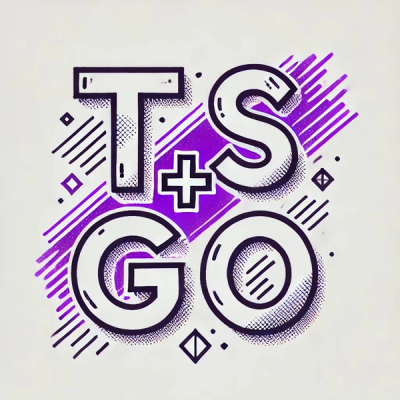







An easy-to-use library for skin tone classification.
This can be used to detect face or skin area in the specified images.
The detected skin tones are then classified into the specified color categories.
The library finally generates results to report the detected faces (if any),
dominant skin tones and color categories.
Check out the Changelog for the latest updates.
If you find this project helpful, please
consider giving it a star ⭐. It would be a great encouragement
for me!
Table of Contents
Showcases
The following are some examples of the classification results using different palettes.
PERLA Palette (default)

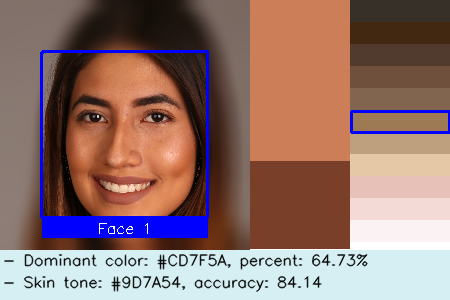
Monk Skin Tone Palette

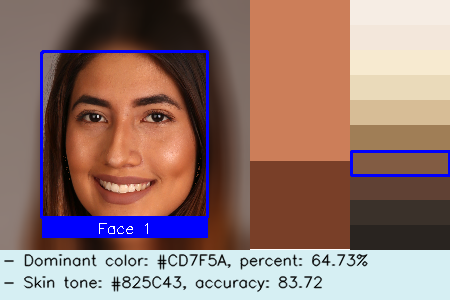
YADON-OSTFELD Palette

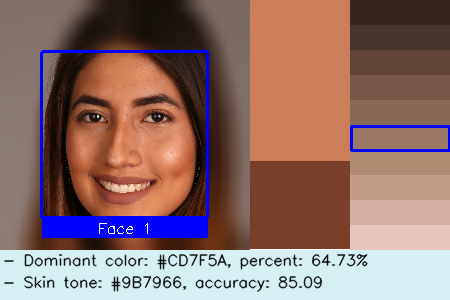
PRODER Palette

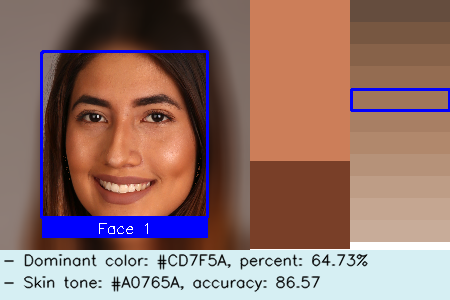
Video tutorials

Please visit the following video tutorials if you have no programming background or are unfamiliar with how to use Python and this library 💖
Playlist

Click here to show more.
1. How to install Python and stone


2. Use stone in GUI mode


3. Use stone in CLI mode


4. Use stone in Python scripts
Please refer to this notebook  for more information.
for more information.
More videos are coming soon...
Installation
[!TIP]
Since v1.2.3, we have made the GUI mode optional.
Install from pip
Install the CLI mode only
pip install skin-tone-classifier --upgrade
It is useful for users who want to use this library in non-GUI environments, e.g., servers or  .
.
Install the CLI mode and the GUI mode
pip install skin-tone-classifier[all] --upgrade
It is useful for users who are not familiar with the command line interface and want to use the GUI mode.
Install from source
git clone git@github.com:ChenglongMa/SkinToneClassifier.git
cd SkinToneClassifier
pip install -e . --verbose
[!TIP]
If you encounter the following problem:
ImportError: DLL load failed while importing _core: The specified module could not be found
Please download and install Visual C++ Redistributable at here.
Then this error will be gone.
HOW TO USE
[!TIP]
You can combine the following documents, the video tutorials above
and the running examples  to understand the usage of this library more intuitively.
to understand the usage of this library more intuitively.
Quick Start
Use stone in a GUI
✨ Since v1.2.0, we have provided a GUI version of stone for users who are not familiar with the command line
interface.

Instead of typing commands in the terminal, you can use the config GUI of stone to process the images.
Steps:
- Open the terminal that can run
stone (e.g., PowerShell in Windows or Terminal in macOS).
- Type
stone (without any parameters) or stone --gui and press Enter to open the GUI.
- Specify the parameters in each tab.
- Click the
Start button to start processing the images.
Hopefully, this can make it easier for you to use stone 🍻!
[!TIP]
-
It is recommended to install v1.2.3+, which supports Python 3.9+.
If you have installed v1.2.0, please upgrade to v1.2.3+ by running
pip install skin-tone-classifier[all] --upgrade
-
If you encounter the following problem:
This program needs access to the screen. Please run with a Framework
build of python, and only when you are logged in on the main display
of your Mac.
Please launch the GUI by running pythonw -m stone in the terminal.
References:
Use stone in command line interface (CLI)
To detect the skin tone in a portrait, e.g.,
Just run:
stone -i /path/to/demo.png --debug
Then, you can find the processed image in ./debug/color/faces_1 folder, e.g.,
In this image, from left to right you can find the following information:
- detected face with a label (Face 1) enclosed by a rectangle.
- dominant colors.
- The number of colors depends on settings (default is 2), and their sizes depend on their proportion.
- specified color palette and the target label is enclosed by a rectangle.
- you can find a summary text at the bottom.
Furthermore, there will be a report file named result.csv which contains more detailed information, e.g.,
| demo.png | color | 1 | #C99676 | 0.67 | #805341 | 0.33 | #9D7A54 | CF | 86.27 |
Interpretation of the table
file: the filename of the processed image.
- NB: The filename pattern of report image is
<file>-<face id>.<extension>
image type: the type of the processed image, i.e., color or bw (black/white).face id: the id of the detected face, which matches the reported image. NA means no face has been detected.dominant n: the n-th dominant color of the detected face.percent n: the percentage of the n-th dominant color, (0~1.0).skin tone: the skin tone category of the detected face.tone label: the label of skin tone category of the detected face.accuracy: the accuracy of the skin tone category of the detected face, (0~100). The larger, the better.
Detailed Usage
To see the usage and parameters, run:
stone -h (or --help)
Detailed usage:
| -h | --help | Show this help message and exit. |
| -i | --images | Image filename(s) or URLs to process.
Supports multiple values separated by space, e.g., a.jpg b.png.
Supports directory or file name(s), e.g., ./path/to/images/ a.jpg.
Supports URL(s), e.g., https://example.com/images/pic.jpg since v1.1.0+.
If you don't specify this option, the app will search all images in the current directory by default. |
| -r | --recursive | Whether to search images recursively in the specified directory. |
| -t | --image_type | Specify whether the input image(s) is/are colored or black/white.
Valid choices are: auto, color, or bw.
Defaults to auto, which will be detected automatically. |
| -p | --palette | Skin tone palette.
Valid choices can be perla, monk, yadon-ostfeld, proder;
You can also input RGB hex values starting with #
or RGB values separated by commas,
e.g., -p #373028 #422811 or -p 255,255,255 100,100,100. |
| -l | --labels | Skin tone labels.
Default values are the UPPERCASE alphabet list leading by the image type
(C for color; B for Black&White),
e.g., ['CA', 'CB', ..., 'CZ'] or ['BA', 'BB', ..., 'BZ']. |
| -d | --debug | Whether to generate report images, used for debugging and verification.
The report images will be saved in the ./debug directory. |
| -bw | --black_white | Whether to convert the input to black/white image(s).
If true, the app will use a black/white palette to classify the image. |
| -o | --output | The path of the output file, defaults to the current directory. |
| --n_workers | The number of workers to process the images,
defaults to the number of CPUs in the system. |
| --n_colors | CONFIG: the number of dominant colors to be extracted, defaults to 2. |
| --new_width | CONFIG: resize the images with the specified width.
Negative value will be ignored, defaults to 250. |
| --scale | CONFIG: how much the image size is reduced at each image scale, defaults to 1.1. |
| --min_nbrs | CONFIG: how many neighbors each candidate rectangle should have to retain it.
Higher value results in fewer detections but with higher quality, defaults to 5. |
| --min_size | CONFIG: minimum possible face size. Faces smaller than that are ignored.
Valid format: width height, defaults to 90 90. |
| --threshold | CONFIG: what percentage of the skin area is required to identify the face,
defaults to 0.15. |
| -v | --version | Show the version number and exit. |
Use Cases
1. Process multiple images
1.1 Multiple filenames
stone -i (or --images) a.jpg b.png https://example.com/images/pic.jpg
1.2 Images in some folder(s)
stone -i ./path/to/images/
NB: Supported image formats: .jpg, .gif, .png, .jpeg, .webp, .tif.
In default (i.e., stone without -i option), the app will search images in current folder.
2. Specify color palette
2.1 Use the built-in palettes
The built-in palettes are: perla, monk, yadon-ostfeld, proderandbw`.
NB: The bw palette is used to classify the black/white images only.
For example:
stone -p (or --palette) perla
The HEX values of each palette are:

perla:
#373028, #422811, #513B2E, #6F503C, #81654F, #9D7A54, #BEA07E, #E5C8A6, #E7C1B8, #F3DAD6, #FBF2F3- Citation: Rejón Piña, R. A., & Ma, C. (2021). Classification Algorithm for Skin Color (CASCo): A new tool to measure skin color in social science research.

monk:
#3A2D1F, #4B3A2A, #5C4A3A, #6D5A4A, #7E6A5A, #8F7A6A, #A08A7A, #B09A8A, #C1AA9A, #D2BAAA, #E3CBCA- Citation: Monk, Ellis. "Monk Skin Tone Scale," 2019. https://skintone.google.

yadon-ostfeld:
#36251d, #48352c, #614539, #755848, #886958, #9b7966, #b18972, #c29c88, #d4afa3, #e6c6bf- Citation: Ostfeld, M. C., & Yadon, N. (2022). Skin color, power, and politics in America. Russell Sage Foundation.

proder:
#654d3e, #775741, #876249, #946c51, #a0765a, #a87f64, #b1886c, #b69279, #be9d86, #c5a691, #c8ac99- Citation: Proyecto sobre discriminación étnico-racial en México (PRODER). El Colegio de México. https://discriminacion.colmex.mx/encuesta-proder/

bw:
#FFFFFF, #F0F0F0, #E0E0E0, #D0D0D0, #C0C0C0, #B0B0B0, #A0A0A0, #909090, #808080, #707070, #606060, #505050, #404040, #303030, #202020, #101010, #000000- Citation: Leigh, A., & Susilo, T. (2009). Is voting skin-deep? Estimating the effect of candidate ballot photographs on election outcomes. Journal of Economic Psychology, 30(1), 61-70.
2.2 Use HEX values
stone -p #373028 #422811 #513B2E
NB: Values start with '#' and are separated by space.
2.3 Use RGB tuple values
stone -p 55,48,40 66,40,17 251,242,243
NB: Values split by comma ',', multiple values are still separated by space.
3. Specify category labels
You can assign the labels for the skin tone categories, for example:
"CA": "#373028",
"CB": "#422811",
"CC": "#513B2E",
...
To achieve this, you can use the -l (or --labels) option:
3.1 Specify the labels directly using spaces as delimiters, e.g.,
stone -l A B C D E F G H
3.2 Specify the range of labels based on this pattern: <start><sep><end><sep><step>.
Specifically,
<start>: the start label, can be a letter (e.g., A) or a number (e.g., 1);<end>: the end label, can be a letter (e.g., H) or a number (e.g., 8);<step>: the step to generate the label sequence, can be a number (e.g., 2 or -1), defaults to 1.<sep>: the separator between <start> and <end>, can be one of these symbols: -, ,, ~, :, ;, _.
Examples:
stone -l A-H-1
which is equivalent to stone -l A-H and stone -l A B C D E F G H.
stone -l A-H-2
which is equivalent to stone -l A C E G.
stone -l 1-8
which is equivalent to stone -l 1 2 3 4 5 6 7 8.
stone -l 1-8-3
which is equivalent to stone -l 1 4 7.
[!IMPORTANT]
Please make sure the number of labels is equal to the number of colors in the palette.
4. Specify output folder
The app puts the final report (result.csv) in current folder in default.
To change the output folder:
stone -o (or --output) ./path/to/output/
The output folder will be created if it does not exist.
In result.csv, each row is showing the color information of each detected face.
If more than one faces are detected, there will be multiple rows for that image.
5. Store report images for debugging
stone -d (or --debug)
This option will store the report image (like the demo portrait above) in
./path/to/output/debug/<image type>/faces_<n> folder,
where <image type> indicates if the image is color or bw (black/white);
<n> is the number of faces detected in the image.
By default, to save storage space, the app does not store report images.
Like in the result.csv file, there will be more than one report images if 2 or more faces were detected.
6. Specify the types of the input image(s)
6.1 The input are color images
stone -t (or --image_type) color
6.2 The input are black/white images
stone -t (or --image_type) bw
6.3 In default, the app will detect the image type automatically, i.e.,
stone -t (or --image_type) auto
7. Convert the color images to black/white images
and then do the classification using bw palette
stone -bw (or --black_white)
For example:

1. Input
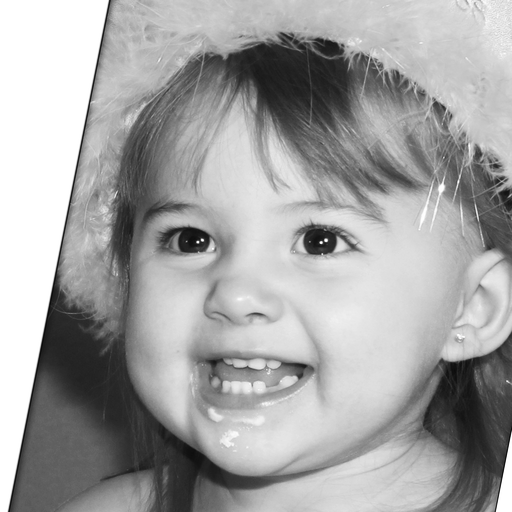
2. Convert to black/white image
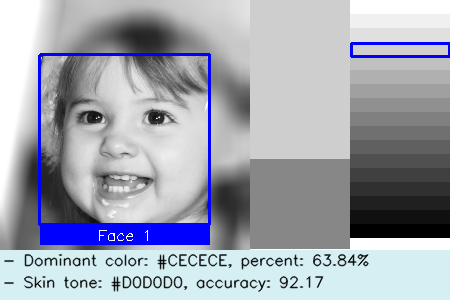
3. The final report image
NB: we did not do the opposite, i.e., convert black/white images to color images
because the current AI models cannot accurately "guess" the color of the skin from a black/white image.
It can further bias the analysis results.
8. Tune parameters of face detection
The rest parameters of CONFIG are used to detect face.
Please refer to https://stackoverflow.com/a/20805153/8860079 for detailed information.
9. Multiprocessing settings
stone --n_workers <Any Positive Integer>
Use --n_workers to specify the number of workers to process images in parallel, defaults to the number of CPUs in your
system.
10. Used as a library by importing into other projects
You can refer to  or the following code snippet:
or the following code snippet:
import stone
from json import dumps
result = stone.process(image_path, image_type, palette, *other_args, return_report_image=True)
report_images = result.pop("report_images")
face_id = 1
stone.show(report_images[face_id])
result_json = dumps(result)
stone.process is the main function to process the image.
It has the same parameters as the command line version.
It will return a dict, which contains the process result and report image(s) (if required,
i.e., return_report_image=True).
You can further use stone.show to show the report image(s).
And convert the result to json format.
The result_json will be like:
{
"basename": "demo",
"extension": ".png",
"image_type": "color",
"faces": [
{
"face_id": 1,
"dominant_colors": [
{
"color": "#C99676",
"percent": "0.67"
},
{
"color": "#805341",
"percent": "0.33"
}
],
"skin_tone": "#9D7A54",
"tone_label": "CF",
"accuracy": 86.27
}
]
}
11. Used in a FAST API project
stone can be used in a FAST API project to classify the skin tone of the uploaded image(s) via POST method.
Please refer to the following code snippet:
from typing import Literal
import stone
from fastapi import FastAPI, UploadFile, HTTPException
from fastapi.responses import JSONResponse
app = FastAPI()
@app.post("/stone")
async def process_image(
image_file: UploadFile,
image_type: Literal["auto", "color", "bw"] = "auto",
tone_palette: list = None,
tone_labels: list = None,
):
image_data = await image_file.read()
temp_file_path = "/tmp/temp_image.jpg"
with open(temp_file_path, "wb") as temp_file:
temp_file.write(image_data)
try:
result = stone.process(
temp_file_path,
image_type=image_type,
tone_palette=tone_palette,
tone_labels=tone_labels,
)
result = JSONResponse(content=result)
except Exception as e:
raise HTTPException(status_code=500, detail=str(e))
return result
To run the demo, please follow these steps:
- Install required packages:
- Run the server:
uvicorn main:app --reload
- You can refine the implementation according to your project requirements.
- Finally, you can use Postman or other HTTP Clients to test the API.
Citation
If you are interested in our work, please cite:
@article{https://doi.org/10.1111/ssqu.13242,
author = {Rej\'{o}n Pi\tilde{n}a, Ren\'{e} Alejandro and Ma, Chenglong},
title = {Classification Algorithm for Skin Color (CASCo): A new tool to measure skin color in social science research},
journal = {Social Science Quarterly},
volume = {n/a},
number = {n/a},
pages = {},
keywords = {colorism, measurement, photo elicitation, racism, skin color, spectrometers},
doi = {https://doi.org/10.1111/ssqu.13242},
url = {https://onlinelibrary.wiley.com/doi/abs/10.1111/ssqu.13242},
eprint = {https://onlinelibrary.wiley.com/doi/pdf/10.1111/ssqu.13242},
abstract = {Abstract Objective A growing body of literature reveals that skin color has significant effects on people's income, health, education, and employment. However, the ways in which skin color has been measured in empirical research have been criticized for being inaccurate, if not subjective and biased. Objective Introduce an objective, automatic, accessible and customizable Classification Algorithm for Skin Color (CASCo). Methods We review the methods traditionally used to measure skin color (verbal scales, visual aids or color palettes, photo elicitation, spectrometers and image-based algorithms), noting their shortcomings. We highlight the need for a different tool to measure skin color Results We present CASCo, a (social researcher-friendly) Python library that uses face detection, skin segmentation and k-means clustering algorithms to determine the skin tone category of portraits. Conclusion After assessing the merits and shortcomings of all the methods available, we argue CASCo is well equipped to overcome most challenges and objections posed against its alternatives. While acknowledging its limitations, we contend that CASCo should complement researchers. toolkit in this area.}
}
Contributing
👋 Welcome to SkinToneClassifier! We're excited to have your contributions. Here's how you can get involved:
-
💡 Discuss New Ideas: Have a creative idea or suggestion? Start a discussion in
the Discussions tab to share your thoughts and
gather feedback from the community.
-
❓ Ask Questions: Got questions or need clarification on something in the repository? Feel free to open
an Issue labeled as a "question" or participate
in Discussions.
-
🐛 Issue a Bug: If you've identified a bug or an issue with the code, please open a
new Issue with a clear description of the problem, steps
to reproduce it, and your environment details.
-
✨ Introduce New Features: Want to add a new feature or enhancement to the project? Fork the repository, create a
new branch, and submit a Pull Request with your changes.
Make sure to follow our contribution guidelines.
-
💖 Funding: If you'd like to financially support the project, you can do so
by sponsoring the repository on GitHub. Your contributions help us
maintain and improve the project.
Disclaimer
The images used in this project are from Flickr-Faces-HQ Dataset (FFHQ),
which is licensed under the Creative Commons BY-NC-SA 4.0 license.
Thank you for considering contributing to SkinToneClassifier.
We value your input and look forward to collaborating with you!

























